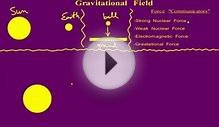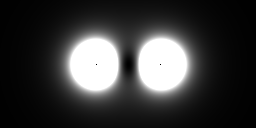
Variation of g with distance from the centre of a uniform spherical mass of radius, R
Variation of g on a line joining the centres of two point masses
If m1 > m2 then
The potential at a point in a gravitational field is equal to the work done bringing a 1kg mass from infinity to that point.
The units are Jkg-1.
To calculate work done by a force we use the equation w = F.s but in this situation it is a little more complicated because the force is not of constant magnitude.
However, we do know how the force varies with distance from the body (Newton’s law of universal gravitation) and it can be shown* that the work done, w, bringing a mass, m, from infinity to point p is given by:
where, M is the mass of the body (the earth, in this case).
*a very useful phrase if you a) don't know how to do something or b) can't be bothered to do it !
A body at infinity, has zero gravitational potential. A body normally falls to its lowest state of potential (energy) so we must arrange that the equation for potential is such that, as r decreases, the potential decreases. We can do this by including a negative sign in the above equation. Then, as r decreases, V decreases (becomes a greater negative quantity).
Therefore, to calculate the potential at a point in the gravitational field of a point mass or a uniformly distributed spherical mass:
If a body is thrown upwards fast enough, it never comes back down: it has escaped from the planet. The velocity needed to do this is called the escape velocity of the planet.
As the body is moving away from the planet, it is losing kinetic energy and gaining potential energy.
To completely escape from the gravitational attraction of the planet, the body must be given enough kinetic energy to take it to a position where its potential energy is zero.
The potential energy possessed by a body of mass m, in a gravitational field is given by:
INTERESTING VIDEO



 In physics, a field is a physical quantity associated with each point of spacetime. A field can be classified as a scalar field, a vector field, a spinor field, or a tensor field according to whether the value of the field at each point is a scalar, a vector, a...
In physics, a field is a physical quantity associated with each point of spacetime. A field can be classified as a scalar field, a vector field, a spinor field, or a tensor field according to whether the value of the field at each point is a scalar, a vector, a...
 In physics, mechanical work is a scalar quantity that can be described as the product of a force times the distance through which it acts, and it is called the work of the force. Only the component of a force in the direction of the movement of its point of...
In physics, mechanical work is a scalar quantity that can be described as the product of a force times the distance through which it acts, and it is called the work of the force. Only the component of a force in the direction of the movement of its point of...








